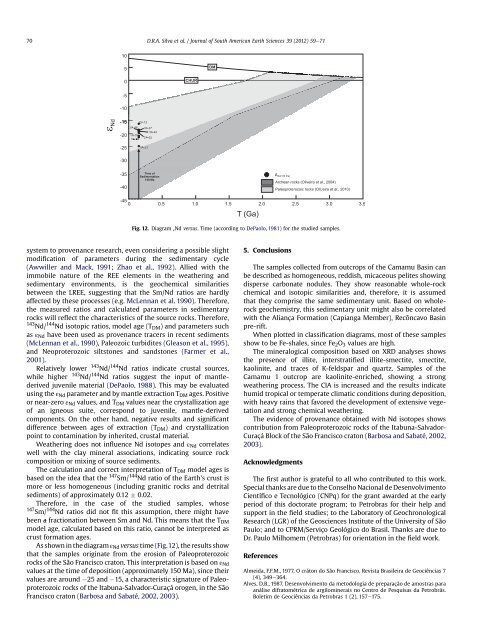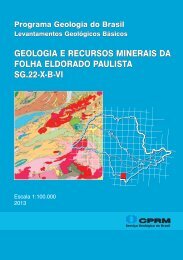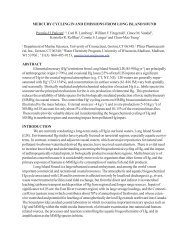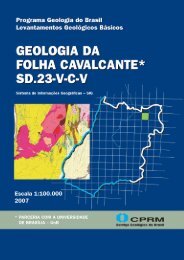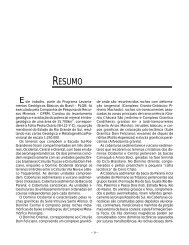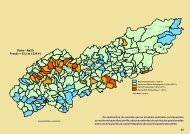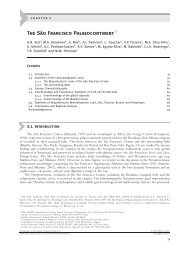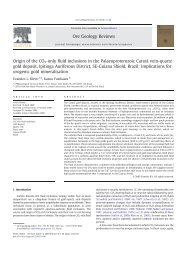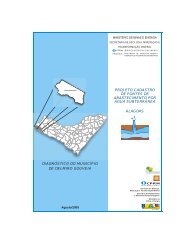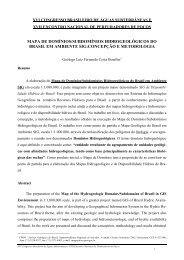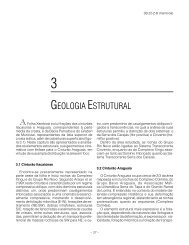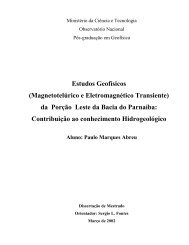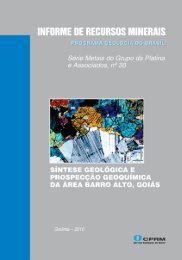70 system to provenance research, even considering a possible slight modification <strong>of</strong> parameters during the sedimentary cycle (Awwiller <strong>and</strong> Mack, 1991; Zhao et al., 1992). Allied with the immobile nature <strong>of</strong> the REE elements in the weathering <strong>and</strong> sedimentary environments, is the geochemical similarities between the LREE, suggesting that the Sm/<strong>Nd</strong> ratios are hardly affected by these processes (e.g. McLennan et al. 1990). Therefore, the measured ratios <strong>and</strong> calculated parameters in sedimentary <strong>rock</strong>s will reflect the characteristics <strong>of</strong> the source <strong>rock</strong>s. Therefore, 143 144 <strong>Nd</strong>/ <strong>Nd</strong> <strong>isotopic</strong> ratios, model age (TDM) <strong>and</strong> parameters such as ε<strong>Nd</strong> have been used as provenance tracers in recent sediments (McLennan et al., 1990), Paleozoic turbidites (Gleason et al., 1995), <strong>and</strong> Neoproterozoic siltstones <strong>and</strong> s<strong>and</strong>stones (Farmer et al., 2001). Relatively lower 143 <strong>Nd</strong>/ 144 <strong>Nd</strong> ratios indicate crustal sources, while higher 143 <strong>Nd</strong>/ 144 <strong>Nd</strong> ratios suggest the input <strong>of</strong> mantlederived juvenile material (DePaolo, 1988). This may be evaluated using the ε<strong>Nd</strong> parameter <strong>and</strong> by mantle extraction TDM ages. Positive or near-zero ε<strong>Nd</strong> values, <strong>and</strong> TDM values near the crystallization age <strong>of</strong> an igneous suite, correspond to juvenile, mantle-derived components. On the other h<strong>and</strong>, negative results <strong>and</strong> significant difference between ages <strong>of</strong> extraction (TDM) <strong>and</strong> crystallization point to contamination by inherited, crustal material. Weathering does not influence <strong>Nd</strong> isotopes <strong>and</strong> ε<strong>Nd</strong> correlates well with the clay mineral associations, indicating source <strong>rock</strong> <strong>composition</strong> or mixing <strong>of</strong> source sediments. The calculation <strong>and</strong> correct interpretation <strong>of</strong> TDM model ages is based on the idea that the 147 Sm/ 144 <strong>Nd</strong> ratio <strong>of</strong> the Earth’s crust is more or less homogeneous (including granitic <strong>rock</strong>s <strong>and</strong> detrital sediments) <strong>of</strong> approximately 0.12 0.02. Therefore, in the case <strong>of</strong> the studied samples, whose 147 144 Sm/ <strong>Nd</strong> ratios did not fit this assumption, there might have been a fractionation between Sm <strong>and</strong> <strong>Nd</strong>. This means that the TDM model age, calculated based on this ratio, cannot be interpreted as crust formation ages. As shown in the diagram ε<strong>Nd</strong> versus time (Fig.12), the results show that the samples originate from the erosion <strong>of</strong> Paleoproterozoic <strong>rock</strong>s <strong>of</strong> the São Francisco craton. This interpretation is based on ε<strong>Nd</strong> values at the time <strong>of</strong> deposition (approximately 150 Ma), since their values are around 25 <strong>and</strong> 15, a characteristic signature <strong>of</strong> Paleoproterozoic <strong>rock</strong>s <strong>of</strong> the Itabuna-Salvador-Curaçá orogen, in the São Francisco craton (Barbosa <strong>and</strong> Sabaté, 2002, 2003). D.R.A. Silva et al. / Journal <strong>of</strong> South American Earth Sciences 39 (2012) 59e71 Fig. 12. Diagram ε<strong>Nd</strong> versus. Time (according to DePaolo, 1981) for the studied samples. 5. Conclusions The samples collected from outcrops <strong>of</strong> the Camamu Basin can be described as homogeneous, reddish, micaceous pelites showing disperse carbonate nodules. They show reasonable whole-<strong>rock</strong> chemical <strong>and</strong> <strong>isotopic</strong> similarities <strong>and</strong>, therefore, it is assumed that they comprise the same sedimentary unit. Based on whole<strong>rock</strong> <strong>geochemistry</strong>, this sedimentary unit might also be correlated with the Aliança Formation (Capianga Member), Recôncavo Basin pre-rift. When plotted in classification diagrams, most <strong>of</strong> these samples show to be Fe-shales, since Fe2O3 values are high. The mineralogical <strong>composition</strong> based on XRD analyses shows the presence <strong>of</strong> illite, interstratified illite-smectite, smectite, kaolinite, <strong>and</strong> traces <strong>of</strong> K-feldspar <strong>and</strong> quartz. Samples <strong>of</strong> the Camamu 1 outcrop are kaolinite-enriched, showing a strong weathering process. The CIA is increased <strong>and</strong> the results indicate humid tropical or temperate climatic conditions during deposition, with heavy rains that favored the development <strong>of</strong> extensive vegetation <strong>and</strong> strong chemical weathering. The evidence <strong>of</strong> provenance obtained with <strong>Nd</strong> isotopes shows contribution from Paleoproterozoic <strong>rock</strong>s <strong>of</strong> the Itabuna-Salvador- Curaçá Block <strong>of</strong> the São Francisco craton (Barbosa <strong>and</strong> Sabaté, 2002, 2003). Acknowledgments The first author is grateful to all who contributed to this work. Special thanks are due to the Conselho Nacional de Desenvolvimento Científico e Tecnológico (CNPq) for the grant awarded at the early period <strong>of</strong> this doctorate program; to Petrobras for their help <strong>and</strong> support in the field studies; to the Laboratory <strong>of</strong> Geochronological Research (LGR) <strong>of</strong> the Geosciences Institute <strong>of</strong> the University <strong>of</strong> São Paulo; <strong>and</strong> to <strong>CPRM</strong>/Serviço Geológico do Brasil. Thanks are due to Dr. Paulo Milhomem (Petrobras) for orientation in the field work. References Almeida, F.F.M., 1977. O cráton do São Francisco. Revista Brasileira de Geociências 7 (4), 349e364. Alves, D.B., 1987. Desenvolvimento da metodologia de preparação de amostras para análise difratométrica de argilominerais no Centro de Pesquisas da Petrobrás. Boletim de Geociências da Petrobras 1 (2), 157e175.
Andersson, P.O.D., Worden, R.H., Hodgson, D.M., Flint, S., 2004. Provenance evolution <strong>and</strong> chemostratigraphy <strong>of</strong> a Palaeozoic submarine fan-complex: Tanqua Karoo basin, South Africa. Marine <strong>and</strong> Petroleum Geology 21, 555e577. Asmus, H.E., Guazelli, W., 1981. Descrição sumária das estruturas da margem continental brasileira e das águas oceânicas e continentais adjacentes e hipóteses sobre o tectonismo causador e implicações para os prognósticos do potencial de recursos. In: Estruturas e tectonismo da margem continental brasileira e avaliação do potencial de recursos minerais. Petrobras/DNPM/ <strong>CPRM</strong>/DHN/CNPq, Rio de Janeiro, pp. 187e189. Série Projeto Remac 9. Awwiller, D.N., Mack, L.E., 1991. Diagenetic modification <strong>of</strong> Sm-<strong>Nd</strong> model ages in tertiary s<strong>and</strong>stones <strong>and</strong> shales, Texas Gulf coast. Geology 19, 311e314. Barbosa, J.S.F., Sabaté, P., 2002. Geological features <strong>and</strong> the paleoproterozoic collision <strong>of</strong> four Archean crustal segments <strong>of</strong> the São Francisco Craton, Bahia, Brazil: a synthesis. Anais da Academia Brasileira de Ciências 74 (2), 343e359. Barbosa, J.S.F., Sabaté, P., 2003. Colagem paleoproterozóica de placas arqueanas do Cráton do São Francisco na Bahia. Revista Brasileira de Geociências 33 (1), 7e14. Bhatia, M.R., 1983. Plate tectonics <strong>and</strong> geochemical <strong>composition</strong> <strong>of</strong> s<strong>and</strong>stones. The Journal <strong>of</strong> Geology 91, 611e627. Brown, G., Brindley, G.W., 1980. X-ray diffraction procedures for clay mineral identification. In: Brown, G., Brindley, G.W. (Eds.), Crystal Structures <strong>of</strong> Clay Minerals <strong>and</strong> Their X-ray Identification, vol. 5. Mineralogical Society <strong>of</strong> London, pp. 305e359. Button, A., Tyler, N., 1979. Precambrian Palaeoweathering <strong>and</strong> Erosion Surfaces in Southern Africa: Review <strong>of</strong> Their Character <strong>and</strong> Economic Significance, vol. 135. Econ. Geol. Res. Unit, Univ. Witwatersr<strong>and</strong>, Johannesburg, Info. Circ, p. 37. Caixeta, J.M., Milhomem, P.S., Witzke, R.E., Dupuy, I.S.S., Gontijo, G.A., 2007. Bacia de Camamu. Boletim de Geociências da Petrobras 15 (2), 455e461. Cesero, P., de Ponte, F.C., 1997. Análise comparativa da paleogeologia dos litorais atlânticos brasileiro e africano. Boletim de Geociências da Petrobras 11 (1), 1e18. Chang, H.K., Kowsmann, R.O., Figueiredo, A.M.F., Bender, A., 1992. Tectonics <strong>and</strong> stratigraphy <strong>of</strong> the East Brazil rift system: an overview. Tectonophysics 213, 97e138. Compston, W., Pidgeon, R.T., 1962. Rubidium-Strontium dating <strong>of</strong> shales by the whole-<strong>rock</strong> method. Journal <strong>of</strong> Geophysical Research 67, 3493e3502. Cox, R., Lowe, D.R., 1995. A conceptual review <strong>of</strong> regional-scale controls on the <strong>composition</strong> <strong>of</strong> clastic sediment <strong>and</strong> the co-evolution <strong>of</strong> continental blocks <strong>and</strong> their sedimentary cover. Journal <strong>of</strong> Sedimentary Research 65, 1e21. DePaolo, D.J., 1981. Neodymium isotopes in the Colorado front range <strong>and</strong> applications for crust formation <strong>and</strong> mantle evolution in the proterozoic. Nature 291, 193e197. DePaolo, D.J., 1988. Neodymium Isotope Geochemistry. Springer-Verlag, Berlin. Estrella, G.O., 1972. O estágio rift nas bacias marginais do Leste Brasileiro. In: Congresso Brasileiro de Geologia, vol. 26. Pará. Sociedade Brasileira de Geologia, Belém, pp. 29e34. Anais, 3. Farmer, G.L., Espinoza, G., Morales, M., Martin, M.W., Bowring, S.W., 2001. <strong>Nd</strong> isotope constraints on sources <strong>of</strong> neoproterozoic to early cambrian siliciclastic sedimentary <strong>rock</strong>s in northern Sonora. Jornal <strong>of</strong> South America Earth Sciences 14, 437e446. Faure, G., 1986. Principles <strong>of</strong> Isotope Geology. John Wiley <strong>and</strong> Sons, New York, 587 pp. Garver, J.I., Royce, P.R., Smick, T.A., 1996. Chromium <strong>and</strong> nickel in shale <strong>of</strong> the Taconic Forel<strong>and</strong>: a case study for the provenance <strong>of</strong> fine-grained sediments with an ultramafic source. Journal <strong>of</strong> Sedimentary Research 66, 100e106. Gleason, J.D., Patchett, P.J., Dickinson, W.R., Ruiz, J., 1995. <strong>Nd</strong> <strong>isotopic</strong> constraints on sediment sources <strong>of</strong> the Ouachita-Marathon fold belt. Geological Society <strong>of</strong> America Bulletin 107 (10), 1192e1210. Goldberg, K., Humayun, M., 2010. The applicability <strong>of</strong> the chemical index <strong>of</strong> alteration as a paleoclimatic indicator: an example from the permian <strong>of</strong> the Paraná basin, Brazil. Palaeogeography, Palaeoclimatology, Palaecology 293, 175e183. Gonçalves, F.T.T., Bedregal, R.P., Coutinho, L.F.C., Mello, M.R., 2000. Petroleum system <strong>of</strong> the Camamu-Almada Basin: a quantitative modeling approach. In: Mello, M.R., Katz, B.J. (Eds.), Petroleum Systems <strong>of</strong> South Atlantic Margins. American Association <strong>of</strong> Petroleum Geologists, pp. 257e271. Memoir n. 73. Hall, A., 1996. Igneous Petrology. Longman, Harlow, p. 550. Herron, M.M., 1988. Geochemical classification <strong>of</strong> terrigenous s<strong>and</strong>s <strong>and</strong> shales from core or log data. Journal <strong>of</strong> Sedimentary Petrology 58, 820e829. Hill, I.G., Worden, R.H., Meighan, I.G., 2000. Geochemical evolution <strong>of</strong> a palaeolaterite: the interbasaltic formation, Northern Irel<strong>and</strong>. Chemical Geology 166, 65e84. D.R.A. Silva et al. / Journal <strong>of</strong> South American Earth Sciences 39 (2012) 59e71 71 Hiscott, R.N., 1984. Ophiolitic source <strong>rock</strong>s for taconic-age flysch: trace-element evidence. Geological Society <strong>of</strong> America, Bulletin 95, 1261e1267. Kasanzu, C., Makenya, A.H., Maboko, S.M., 2008. Geochemistry <strong>of</strong> fine-grained clastic sedimentary <strong>rock</strong>s <strong>of</strong> the Neoproterozoic Ikorongo Group, NE Tanzania: implications for provenance <strong>and</strong> source <strong>rock</strong> weathering. Precambrian Research 164, 201e213. Kessarkar, P.M., Rao, V.P., Ahmad, S.M., Anil Babu, G., 2003. Clay minerals <strong>and</strong> <strong>Sr</strong>-<strong>Nd</strong> isotopes <strong>of</strong> the sediments along the western margin <strong>of</strong> India <strong>and</strong> their implications for sediment provenance. Marine Geology 202, 55e69. Ludwig, K.R., 2003. Isoplot/Ex 3.00: A Geochronological Toolkit for Micros<strong>of</strong>t Excel. Berkeley Geochronology Center, Berkeley. Available: http://www.bgc.org/ klprogrammenu.html (Acessoem 29.11.06.). McLennan, S.M., 1989. Rare earth elements in sedimentary <strong>rock</strong>s: influence <strong>of</strong> provenance <strong>and</strong> sedimentary processes. Reviews in Mineralogy 21, 169e200. McLennan, S.M., Taylor, S.R., McCulloch, M.T., Maynard, J.B., 1990. Geochemical <strong>and</strong> <strong>Nd</strong>-<strong>Sr</strong> <strong>isotopic</strong> <strong>composition</strong> <strong>of</strong> deep-sea turbidites: crustal evolution <strong>and</strong> platetectonic associations. Geochimica et Cosmochimica Acta 54, 2015e2050. Middleton, G.V., 1960. Chemical <strong>composition</strong> <strong>of</strong> s<strong>and</strong>stones. Geological Society <strong>of</strong> America, Bulletin 71, 1011e1026. Mizusaki, A.M.P., 1992. Comportamento do Rb e do <strong>Sr</strong> em sedimentos recentes: implicação na datação radiométrica de rochas sedimentares. São Paul, 140 p. Tese de Doutorado. Instituto de Geociências da Universidade de São Paulo. Mizusaki, A.M.P., Kawashita, K., Thomaz Filho, A., 1998. Razão Isotópica 87 <strong>Sr</strong>/ 86 <strong>Sr</strong> em Sedimentos Recentes: Implicações na Datação Radiométrica das Rochas Sedimentares. Pesquisas 25 (1), 75e88. Nesbitt, H.W., Markovics, G., Price, R.C., 1980. Chemical processes affecting alkalis <strong>and</strong> alkaline earths during continental weathering. Geochimica et Cosmochimica Acta 44 (11), 1659e1666. Nesbitt, H.W., Young, G.M., 1982. Early proterozoic climates <strong>and</strong> plate motions inferred from major element chemistry <strong>of</strong> lutites. Nature 299, 715e717. Netto, A.S.T., Ragagnin, G.M., 1990. Compartimentação exploratória da Bacia de Camamu, Bahia. In: Congresso Brasileiro de Geologia, vol. 1. Sociedade Brasileira de Geologia, 36, Natal. Anais, pp. 171e182. Norrish, K., Pickering, J.G., 1983. Clay Minerals. Soils, An Australian Viewpoint. CSIRO, Melbourne, pp. 281e308. Piper, D.Z., 1974. Rare earth elements in the sedimentary cycle: a summary. Chemical Geology 14, 285e304. Ponte, F.C., Asmus, H.E., 1976. The Brazilian marginal basins: current state <strong>of</strong> knowledge. Anais da Academia Brasileira de Ciências 48, 215e239. Roddaz, M., Viers, J., Brusset, S., Baby, P., Boucayr<strong>and</strong>, C., Herail, G., 2006. Controls on weathering <strong>and</strong> provenance in the Amazonian forel<strong>and</strong> basin: insights from major <strong>and</strong> trace element <strong>geochemistry</strong> <strong>of</strong> Neogene Amazonian sediments. Chemical Geology 226 (1), 31e65. Roser, B., 2000. <strong>Whole</strong> <strong>rock</strong> <strong>geochemistry</strong> studies <strong>of</strong> clastic sedimentary suites. Memoirs <strong>of</strong> the Geological Society <strong>of</strong> Japan 57, 73e89. Servaraj, K., Arthur, C.C., 2006. Moderate Chemical weathering <strong>of</strong> subtropical Taiwan: constraints fromsolid-phase <strong>geochemistry</strong> <strong>of</strong> sediments <strong>and</strong> sedimentary <strong>rock</strong>s. Journal <strong>of</strong> Geology 114, 101e116. Silva, D.R.A., Mizusaki, A.M.P., Milani, E., Tassinari, C.C., 2006. Idade deposicional da Formação Bananeiras (Bacia de Sergipe-Alagoas): uma aplicação do método radiométrico Rb-<strong>Sr</strong> em rochas sedimentares. Boletim de Geociências da Petrobras 14 (2), 235e245. Silva, D.R.A., Mizusaki, A.M.P., Milani, E., Pimentel, M., 2012. Determination <strong>of</strong> depositional age <strong>of</strong> paleozoic <strong>and</strong> pre-rift supersequences <strong>of</strong> the Recôncavo Basin in northeastern Brazil by applying Rb-<strong>Sr</strong> radiometric dating technique to sedimentary <strong>rock</strong>s. Journal <strong>of</strong> South America Earth Sciences 37, 13e24. Taylor, S.R., McLennan, S.M., 1985. The Continental Crust: Its Composition <strong>and</strong> Evolution. Blackwell Scientific, Oxford, 312 pp. Thomaz Filho, A., Lima, V.Q., 1979. Datação radiométrica de rochas sedimentares pelíticas pelo método Rb-<strong>Sr</strong>. Petrobras. CENPES, Rio de Janeiro. Relatório interno. Visser, J.N.J., Young, G.M., 1990. Major element <strong>geochemistry</strong> <strong>and</strong> paleoclimatology <strong>of</strong> the permo-carboniferous glacigene dwyka formation <strong>and</strong> post-glacial mud<strong>rock</strong>s in southern Africa. Palaeogeography, Palaeoclimatology, Palaecology 81, 49e57. Weaver, C.E., 1989. Clays, Muds <strong>and</strong> Shales: Developments in Sedimentology, vol. 44. Elsevier, Amsterdan, 819 pp. Zhao, J.X., McCulloch, M.T., Bennett, V.C., 1992. Sm-<strong>Nd</strong> <strong>and</strong> U-Pb zircon <strong>isotopic</strong> constraints on the provenance <strong>of</strong> sediments <strong>of</strong> the Amadeus Basin, central Australia: evidence for REE fractionation. Geochimica et Cosmochimica Acta 56, 921e940.


